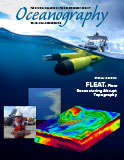Article Abstract
Complex interactions between open ocean and nearshore environments pose a predictability problem. Basin-scale ocean models are typically run at grid scales that do not accurately resolve individual islands, and model output is assessed mostly using observations of the open ocean. Thus, model ability to replicate island forereef oceanic variability has gone largely untested. Here, an eight-year regional state estimate covering 2009–2017 is compared to bottom temperature observations at the western Pacific islands of Palau and Pohnpei, and is found to reproduce the observed seasonal to interannual variability. Because of their steep bathymetry, these islands can act as moorings. Sea surface variables, such as temperature (SST) and height (SSH), have been shown to predict upper ocean thermal structure in the region, but the spatial structure of the relationship has gone unexplored. The state estimate was used to examine the multivariate predictability of temperature at depths to about 200 m both at the island boundaries and throughout the domain. The results show that the best multiple linear regression (MLR) skill was found near Palau, but useful skill (>0.6) was available through much of the region within the anticyclonic gyre driven by positive wind-stress curl. Point SSH measurements offered prediction skill for areas extending a few hundred kilometers zonally and perhaps 100 km meridionally. The insights into the additional information contained in surface variables in this region could aid in advancement of ocean modeling as well as predictions of ecological patterns and stressors.

